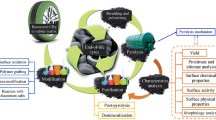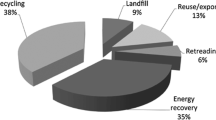Abstract
Thermal pyrolysis of waste tires is an industrially beneficial method for material and energy recovery. Pyrolytic carbon black (CBp) is considered to be the secondary main product of this process. In the present study, an eco-friendly and economically feasible autoclave reactor-based thermal pyrolysis method was employed for the pyrolysis of waste tire tread. The average yields obtained for CBp and pyrolytic liquid are 48.2 wt% and 46.3 wt%, respectively. This CBp was well characterized by several techniques and results were compared with those of commercially available N330 carbon black. Elemental analysis shows that CBp has higher oxygen (O) and sulfur (S) content. Furthermore, the surface attachment of ash with carbon black from morphological analysis reveals the presence of higher ash content in CBp, which is further justified by proximate and thermal analysis. Zinc oxide (ZnO) plays a vital role in sulfur vulcanization and is added during the compounding stage of the tire-manufacturing process. Results obtained from TEM–EDX analysis indicate the presence of ZnO in the carbon black derived from thermal pyrolysis. Prior to conducting further research in this area, we may draw the conclusion from the experimental results that the obtained CBp has similar characteristic features and can be used in place of commercially available carbon black for the manufacture of rubber products.
Graphical Abstract











Similar content being viewed by others
Data availability
The data are available from the corresponding author on reasonable request.
References
Ramadan BS, Rachman I, Ikhlas N et al (2022) A comprehensive review of domestic-open waste burning: recent trends, methodology comparison, and factors assessment. J Mater Cycles Waste Manag 24:1633–1647. https://doi.org/10.1007/s10163-022-01430-9
Tian X, Zhuang Q, Han S et al (2021) A novel approach of reapplication of carbon black recovered from waste tyre pyrolysis to rubber composites. J Clean Prod 280:124460. https://doi.org/10.1016/j.jclepro.2020.124460
Massoud MA, Mokbel M (2022) Determinants of waste characterization in Lebanon and material recovery potential. J Mater Cycles Waste Manag 24:1913–1922. https://doi.org/10.1007/s10163-022-01445-2
Chauhan A, Sharma NK, Tayal S et al (2022) A sustainable production model for waste management with uncertain scrap and recycled material. J Mater Cycles Waste Manag 24:1797–1817. https://doi.org/10.1007/s10163-022-01435-4
Yazdani E, Hashemabadi SH, Taghizadeh A (2019) Study of waste tire pyrolysis in a rotary kiln reactor in a wide range of pyrolysis temperature. Waste Manag 85:195–201. https://doi.org/10.1016/j.wasman.2018.12.020
Mustafa AB, Dong H, Zhang C, Fujii M (2022) Life cycle environmental benefit and waste-to-energy potential of municipal solid waste management scenarios in Indonesia. J Mater Cycles Waste Manag 24:1859–1877. https://doi.org/10.1007/s10163-022-01441-6
Ramarad S, Khalid M, Ratnam CT et al (2015) Waste tire rubber in polymer blends: A review on the evolution, properties and future. Prog Mater Sci 72:100–140. https://doi.org/10.1016/j.pmatsci.2015.02.004
Murillo R, Aylón E, Navarro MV et al (2006) The application of thermal processes to valorise waste tyre. Fuel Process Technol 87:143–147. https://doi.org/10.1016/j.fuproc.2005.07.005
Martínez JD, Murillo R, García T, Arauzo I (2014) Thermodynamic analysis for syngas production from volatiles released in waste tire pyrolysis. Energy Convers Manag 81:338–353. https://doi.org/10.1016/j.enconman.2014.02.031
Islam MR, Islam MN, Mustafi NN et al (2013) Thermal recycling of solid tire wastes for alternative liquid fuel: The first commercial step in Bangladesh. Procedia Eng 56:573–582. https://doi.org/10.1016/j.proeng.2013.03.162
Wang K, Xu Y, Duan P et al (2019) Thermo-chemical conversion of scrap tire waste to produce gasoline fuel. Waste Manag 86:1–12. https://doi.org/10.1016/j.wasman.2019.01.024
Nisar J, Ali G, Ullah N et al (2018) Pyrolysis of waste tire rubber: Influence of temperature on pyrolysates yield. J Environ Chem Eng 6:3469–3473. https://doi.org/10.1016/j.jece.2018.05.021
Costa GA, dos Santos RG (2019) Fractionation of tire pyrolysis oil into a light fuel fraction by steam distillation. Fuel 241:558–563. https://doi.org/10.1016/j.fuel.2018.12.075
Martínez JD, Cardona-Uribe N, Murillo R et al (2019) Carbon black recovery from waste tire pyrolysis by demineralization: Production and application in rubber compounding. Waste Manag 85:574–584. https://doi.org/10.1016/j.wasman.2019.01.016
Badughaish A, Wang J, Hettiarachchi C, Xiao F (2022) A review on the crumb rubber-modified asphalt in the Middle East. J Mater Cycles Waste Manag 24:1679–1692. https://doi.org/10.1007/s10163-022-01455-0
Kumar Singh R, Ruj B, Jana A et al (2018) Pyrolysis of three different categories of automotive tyre wastes: Product yield analysis and characterization. J Anal Appl Pyrolysis 135:379–389. https://doi.org/10.1016/j.jaap.2018.08.011
Huang K, Gao QH, Tang LH et al (2005) A comparison of surface morphology and chemistry of pyrolytic carbon blacks with commercial carbon blacks. Powder Technol 160:190–193. https://doi.org/10.1016/J.POWTEC.2005.08.011
Cardona N, Campuzano F, Betancur M et al (2018) Possibilities of carbon black recovery from waste tyre pyrolysis to be used as additive in rubber goods -a review. IOP Conf Ser Mater Sci Eng. https://doi.org/10.1088/1757-899X/437/1/012012
Collin G (1980) Pyrolytic recovery of raw materials from special wastes. ACS Symp Ser. https://doi.org/10.1021/BK-1980-0130.CH034
Bozkurt PA, Canel M (2014) Co-extraction of Lignite and Waste Tire Mixtures. Energy Sour Part A Recov Utiliz Environ Effects Co-extract Lignite Waste Tire Mixtures Co-extract Lignite Waste Tire Mixtures. https://doi.org/10.1080/15567036.2013.807320
Oboirien BO, North BC (2017) A review of waste tyre gasification. J Environ Chem Eng 5:5169–5178. https://doi.org/10.1016/j.jece.2017.09.057
Galvagno S, Casu S, Casabianca T et al (2002) Pyrolysis process for the treatment of scrap tyres: Preliminary experimental results. Waste Manag 22:917–923. https://doi.org/10.1016/S0956-053X(02)00083-1
Roy C, Chaala A, Darmstadt H (1999) Vacuum pyrolysis of used tires end-uses for oil and carbon black products. J Anal Appl Pyrolysis 51:201–221. https://doi.org/10.1016/S0165-2370(99)00017-0
Cunliffe AM, Williams PT (1998) Composition of oils derived from the batch pyrolysis of tyres. J Anal Appl Pyrolysis 44:131–152. https://doi.org/10.1016/S0165-2370(97)00085-5
Donnet JB, Bansal RC, Wang M-J (1993) Carbon black. Sci Technol. https://doi.org/10.1201/9781315138763
Bertrand P, Weng LT (1999) Carbon black surface characterization by TOF-SIMS and XPS. Rubber Chem Technol. https://doi.org/10.5254/1.3538809
Dong P, Maneerung T, Ng WC et al (2017) Chemically treated carbon black waste and its potential applications. J Hazard Mater 321:62–72. https://doi.org/10.1016/J.JHAZMAT.2016.08.065
Clauzade C, Osset P, Hugrel C et al (2010) Life cycle assessment of nine recovery methods for end-of-life tyres. Int J Life Cycle Assess 15:883–892. https://doi.org/10.1007/S11367-010-0224-Z
Dwivedi C, Manjare S, Rajan SK (2020) Recycling of waste tire by pyrolysis to recover carbon black: Alternative & environment-friendly reinforcing filler for natural rubber compounds. Compos Part B Eng 200:108346. https://doi.org/10.1016/J.COMPOSITESB.2020.108346
Darmstadt H, Roy C, Kaliaguine S, Xu G, Auger M, Tuel A, Ramaswamy V (2000) Solid-state 13C-NMR spectroscopy and XRD studies of commercial and pyrolytic carbon blacks. Carbon N Y 38:1279–1287. https://doi.org/10.1016/S0008-6223(99)00259-6
Kawakami S, Inoue K, Tanaka H, Sakai T (1980) Pyrolysis process for scrap tires. ACS Symp Ser. https://doi.org/10.1021/BK-1980-0130.CH040
Wang M, Zhang L, Li A et al (2019) Comparative pyrolysis behaviors of tire tread and side wall from waste tire and characterization of the resulting chars. J Environ Manag 232:364–371. https://doi.org/10.1016/j.jenvman.2018.10.091
Cataldo F (2020) Pyrolytic carbon black from truck tires: some new analytical approaches. Fullerenes Nanotub Carbon Nanostr 29:304–314. https://doi.org/10.1080/1536383X.2020.1839426
Lee WH, Kim JY, Ko YK et al (1999) Surface analysis of carbon black waste materials from tire residues. Appl Surf Sci 141:107–113. https://doi.org/10.1016/S0169-4332(98)00600-X
Maniwa Y, Kataura H, Abe M et al (2002) Phase Transition in Confined Water Inside Carbon Nanotubes. J Phys Soc Japan 71:2863–2866. https://doi.org/10.1143/JPSJ.71.2863
Mustafi NN, Raine RR, James B (2010) Characterization of exhaust particulates from a dual fuel engine by TGA, XPS, and Raman techniques. Aerosol Sci Technol 44:954–963. https://doi.org/10.1080/02786826.2010.503668
Onyeka Okoye C, Zhu M, Jones I et al (2022) An investigation into the preparation of carbon black by partial oxidation of spent tyre pyrolysis oil. Waste Manag 137:110–120. https://doi.org/10.1016/J.WASMAN.2021.10.027
Kyari M, Cunliffe A, Williams PT (2005) Characterization of oils, gases, and char in relation to the pyrolysis of different brands of scrap automotive tires. Energy Fuels 19:1165–1173. https://doi.org/10.1021/ef049686
Acknowledgements
N. C. Das would like to thank the Ministry of Education (MoE) and Science and Engineering Research Board (SERB), Government of India, with grant no. IMP/2018/000145.
Author information
Authors and Affiliations
Corresponding author
Additional information
Publisher's Note
Springer Nature remains neutral with regard to jurisdictional claims in published maps and institutional affiliations.
Rights and permissions
Springer Nature or its licensor (e.g. a society or other partner) holds exclusive rights to this article under a publishing agreement with the author(s) or other rightsholder(s); author self-archiving of the accepted manuscript version of this article is solely governed by the terms of such publishing agreement and applicable law.
About this article
Cite this article
Paul, S., Rahaman, M., Ghosh, S.K. et al. Recycling of waste tire by pyrolysis to recover carbon black: an alternative reinforcing filler. J Mater Cycles Waste Manag 25, 1470–1481 (2023). https://doi.org/10.1007/s10163-023-01635-6
Received:
Accepted:
Published:
Issue Date:
DOI: https://doi.org/10.1007/s10163-023-01635-6




